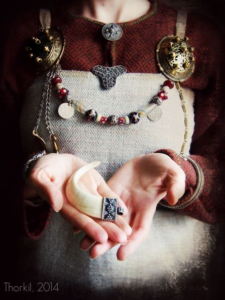 Today the Department of ALM got visited by Bodil Axelsson, associate professor at Linköping University at the Department for Studies of Social Change and Culture. She presented her ongoing research project In Orbit: Distributed Curatorial Agency When Museum Objects and Knowledge Go Online. The data she presented illustrated what happens when images of museum objects are published and pinned on Pinterest and how that throw those objects into a process of re-contextualisation. Her study focus on images of viking jewelry, an object category that is widely spread outside the museum pinning boards on Pinterest where they were originally published.
Today the Department of ALM got visited by Bodil Axelsson, associate professor at Linköping University at the Department for Studies of Social Change and Culture. She presented her ongoing research project In Orbit: Distributed Curatorial Agency When Museum Objects and Knowledge Go Online. The data she presented illustrated what happens when images of museum objects are published and pinned on Pinterest and how that throw those objects into a process of re-contextualisation. Her study focus on images of viking jewelry, an object category that is widely spread outside the museum pinning boards on Pinterest where they were originally published.
Her research is one example of how new digital practices (like the use of Pinterest and other social media) are forcing researchers in information science, cultural heritage studies or other related domains to study the effects of the digital era on institutional collections.
Pinterest is a social media platform that allows the user to publish images and image metadata of their choice. Users can also “pin” images to create their own collections of material relevant only for them, much in likeness with the old school scrap book. As opposed to scrap books, the pinning activity enables images to spread and act as nodes in different networks. Collections of pinned images are also used to make recommendations of new images to pin. It is all machined by a complicated and opaque algorithm that tries to learn the interests of the platform users to make useful recommendations.
